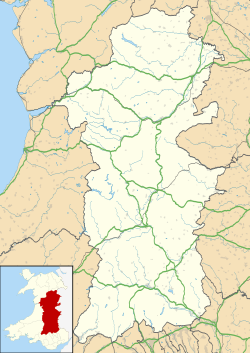|
Slwch Tump
Slwch Tump, also known as Slwch Camp and formerly known as Pen Cevn-y-Gaer,[3] is an Iron Age hillfort close to Brecon in Powys, Wales. SiteThe enclosure is located on a hill composed of sandstones of the St Maughans Formation[4] with an elevation of 807 ft (246 m), about 0.8 miles (1.3 km) east of the confluence of the Rivers Usk and Honddu in the centre of Brecon.[1] The hillfort can be accessed by a public footpath which joins Slwch Lane north of the site and loops around the rampart.[2] DescriptionThe hillfort is smaller than the one on nearby Pen-y-crug[3] and is irregular but roughly rectangular in shape, measuring about 187 m by 242 m, with a single encircling rampart.[1] Samuel Lewis described it in 1845 as "defended by a double fosse, which is in some places nearly destroyed".[3] Its entrance is on the north-west side, towards Brecon.[1] Today its form is somewhat obscured by hedges and trees.[2] Within the hillfort area there are remains of abandoned quarries for building stone.[5] St ElunedA small church stood for some time at Slwch Tump, marking the place where Saint Eluned was supposedly beheaded. Eluned was one of the daughters of the 5th-century King Brychan of Brycheiniog and, as a Christian, she refused a pagan prince's marriage proposal and fled from him. At Slwch Tump, the local lord permitted her to build herself a cell, where she lived until her spurned suitor found her. As she ran from him, he cut off her head with his sword. A spring of water appeared and her cell became a small church, which remained on the site, latterly in a ruinous state, until 1698.[6] Before the Reformation, the spring was associated with healing and other miracles. See alsoReferences
|
||||||||||||||||||||||

